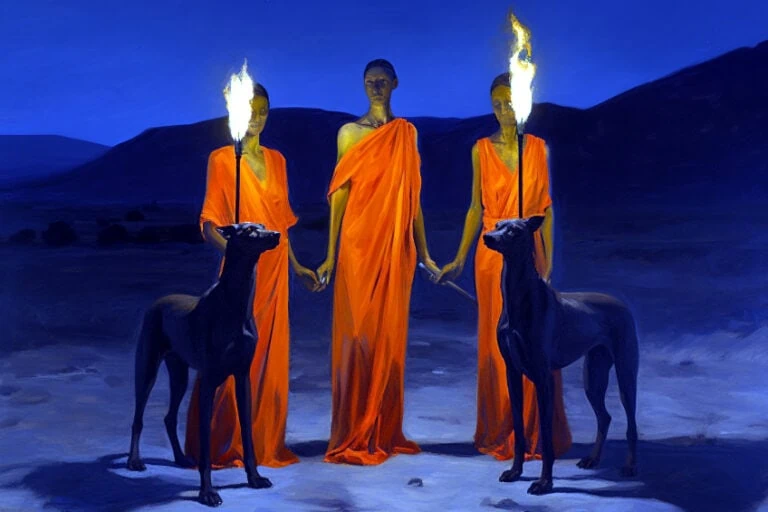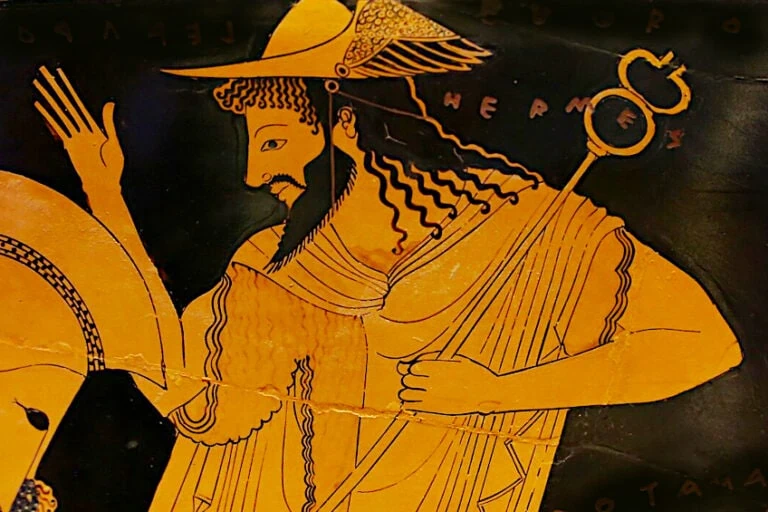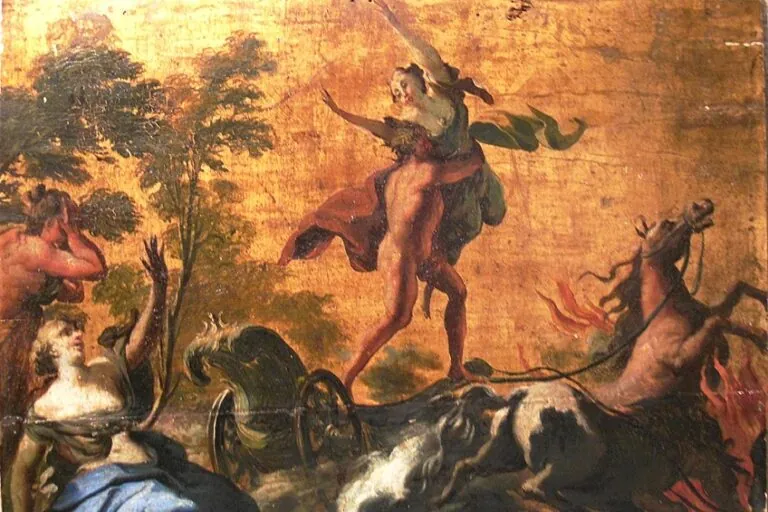Greek Goddess Nyx – Primordial Night Personified
What is Nyx the goddess of, and where does Nyx live? Nyx, the goddess of night divides her time between the sky and the murky depths of Tartarus. She was an ancient divinity generally conceived of as the night itself, a misty veil that spread across the evening sky. The Greek goddess Nyx was typically portrayed as winged and riding in a chariot. In some images, she may also hold a torch. Below, we shall delve into the Nyx facts and myths that provide insight into her character and role in Greek mythology.
The Mythology of Nyx, Goddess of Night
| Name | Nyx |
| Gender | Female |
| Symbols | Wings, dark mist, chariot, torch |
| Personality | Powerful, distant, and independent |
| Domains | Night, shadows, dreams, and stars |
| Parents | Chaos or Eros |
| Spouse | Erebus |
Nyx was so important in the Greek notion of the world that she existed even before day or light. Some cults claimed the Greek goddess Nyx was so powerful that she created everything in the cosmos, even the earth itself. Nyx, like the terrifying qualities of the night she symbolized, was a goddess who was able to create significant terror and was feared as a force that could subdue men and gods alike.
Even Zeus knew not to offend Nyx, the mother of many illnesses and the companion of darkness. Nyx could, however, also be a source of affection, comfort, and rest. She was seen as a benign goddess by many.
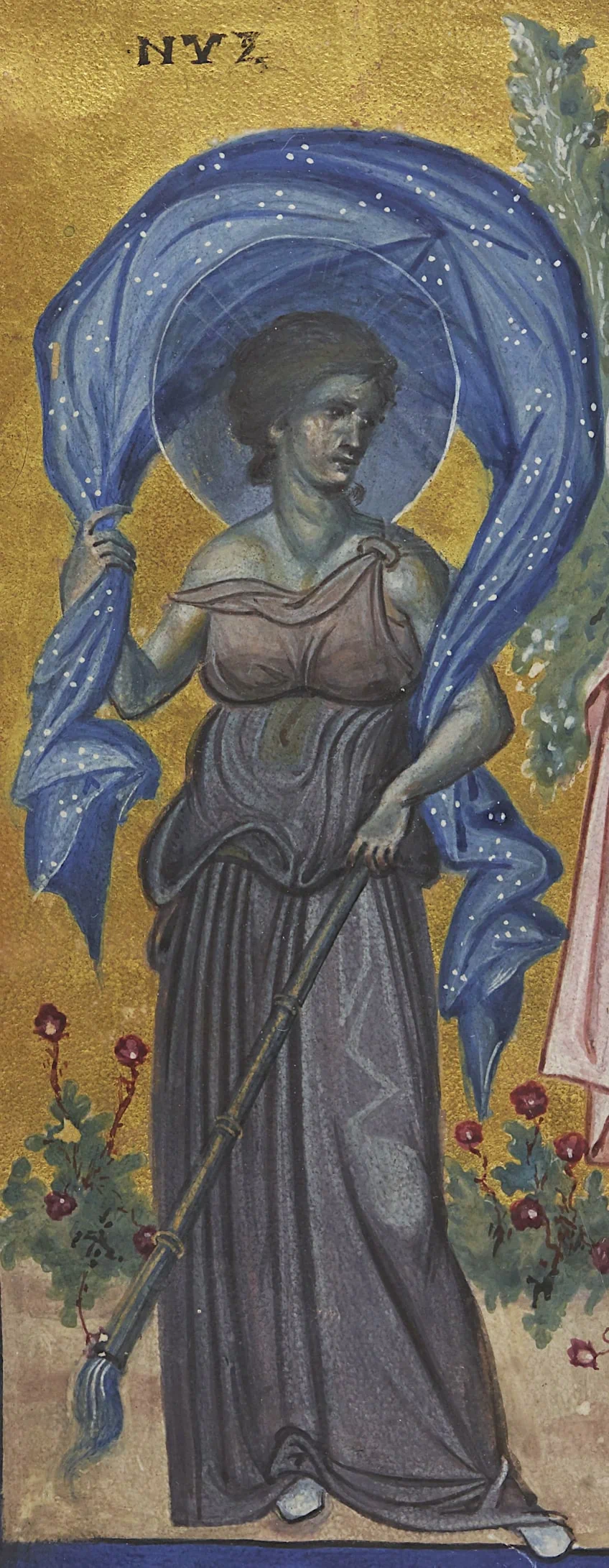 Detail of an illustration from a Greek manuscript psalter showing Nyx (c. 940-960 CE); Bibliothèque nationale de France, Public domain, via Wikimedia Commons
Detail of an illustration from a Greek manuscript psalter showing Nyx (c. 940-960 CE); Bibliothèque nationale de France, Public domain, via Wikimedia Commons
The Greek Goddess Nyx’s Background and Family
Nyx, the goddess of night was a primordial deity who appeared at the very inception of the cosmos. She was birthed from Chaos, based on most stories, making her a sibling of other important primordial deities such as Tartarus and Gaia. These ancient deities symbolized the universe’s basic foundations. They were the source of all subsequent life and substance. Nyx wasn’t simply the ruler of the night; she was regarded as the night itself. This meant that, like the other primordial divinities, she had no shape and little characterization beyond this element.
In other versions of her myth Nyx was the daughter of Eros in his role as the unifying force of the cosmos.
She was represented as robed in black mists and surrounded by stars, or with wings that she used to soar through the black sky, although she was usually pulled by a great chariot. The chariot traveling through the sky was a popular motif in ancient Greek cosmology, and she shared it with the sun deity Helios and his moon sister Selene. Nyx, on the other hand, had a black chariot drawn by either a group of black horses or a couple of black bulls.
 Black-figure lekythos showing Helios in his four-horse chariot below Nyx and Eos in their chariots above him (c. 500 BCE); Ismoon (talk) 21:17, 14 March 2022 (UTC), CC BY-SA 4.0, via Wikimedia Commons
Black-figure lekythos showing Helios in his four-horse chariot below Nyx and Eos in their chariots above him (c. 500 BCE); Ismoon (talk) 21:17, 14 March 2022 (UTC), CC BY-SA 4.0, via Wikimedia Commons
Family
Nyx, the goddess of night, was usually associated with the personification of darkness, Erebus. Both had evolved from Chaos and were inextricably linked. Erebus was regarded as the deity of all darkness, from the gloomy realms at the world’s edge to the deep caverns where sunlight could not penetrate. He followed the Greek goddess Nyx, his consort and sister, as she made her way across the sky.
Uranus, the sky, was perceived as a massive brass dome that stretched above the ground. He would not appear blue until the Titaness Theia took her place in the sky. He would also not be affected by sunlight.
Only Nyx and Erebus drove a black chariot over Uranus at first. Their offspring, Aether (Brightness) and Hemera (Day) would be the first to illuminate Uranus as well as Gaia’s surface. Her offspring became her polar opposites, balancing their mother’s and father’s abilities. While Nyx dominated the night sky, Hemera ruled the day. According to Hesiod, the two deities inhabited a dwelling near the world’s edges. They exchanged greetings at the door in the morning and at dusk, but they never occupied the residence at the exact same time.
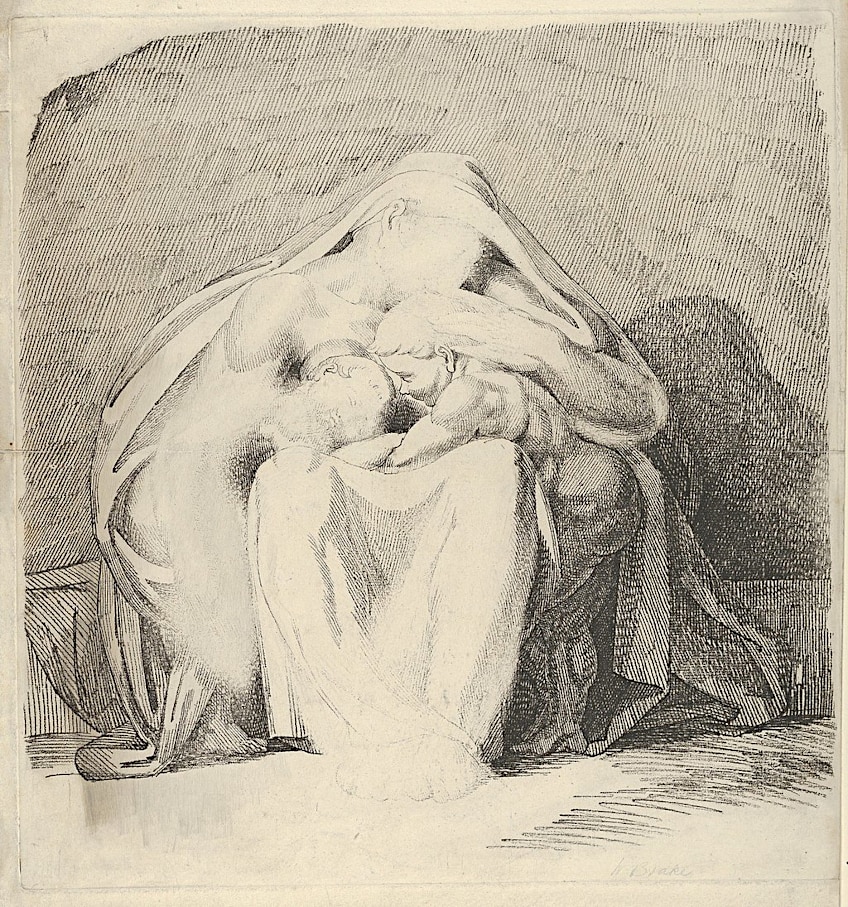 Night and her Children Aither and Hemera by Henry Fuseli (c. 1810-1815); Henry Fuseli, CC0, via Wikimedia Commons
Night and her Children Aither and Hemera by Henry Fuseli (c. 1810-1815); Henry Fuseli, CC0, via Wikimedia Commons
Where Did Nyx Live?
In mythology, the Greek goddess Nyx was thought to reside in the depths of the underworld, either in hades or in an even deeper place called Tartarus. Nyx is often depicted as living in a fortress or cave within Tartarus. She would emerge from this dimension each night, spreading her dark curtain over the Earth and letting the night unfold. While Tartarus was the major realm linked with Nyx’s abode, her power went beyond a single geographical area. Nyx was ubiquitous as a primordial deity, representing the essence of night and darkness across the cosmos.
Her presence pervaded the nighttime hours and the world’s dark corners, spanning both the physical and spiritual realms. Tartarus, like Gaia and Uranus, sprung from the emptiness of Chaos.
It was not just a primeval force, but also a location, a deep hole far below Hades, where the most evil were transported after death to suffer and be tortured for their misdeeds. According to Plato, a great Greek philosopher, here is where the departed souls of the deceased are judged. Tartarus, according to the Greek poet Hesiod, was the third deity to appear at the beginning of time, following Chaos and Gaia.
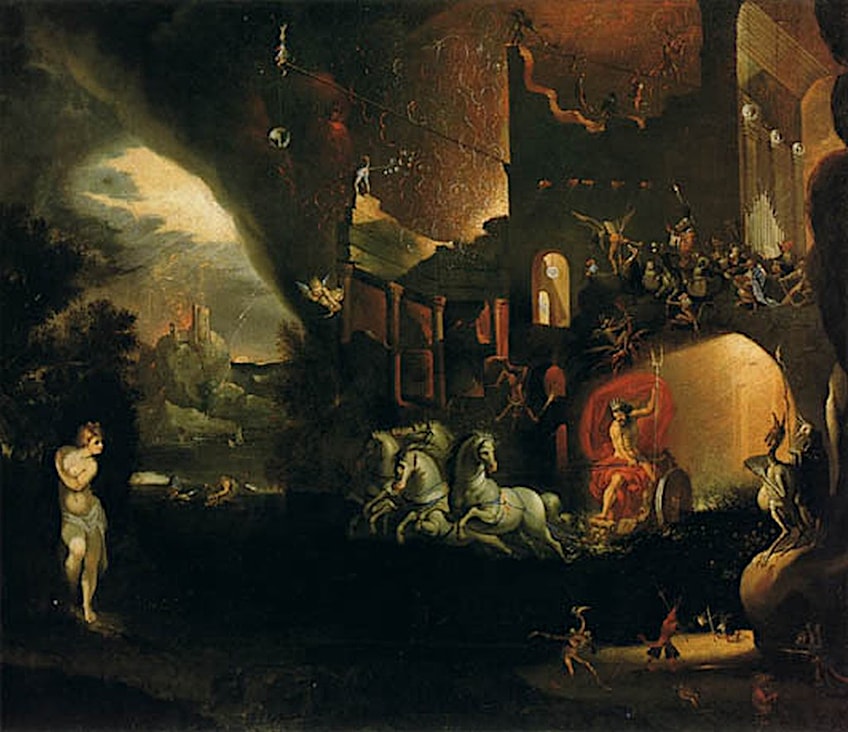 The Arrival of Hades in Tartarus by Joseph Heintz the Younger (c. 1640); Joseph Heintz the Younger, Public domain, via Wikimedia Commons
The Arrival of Hades in Tartarus by Joseph Heintz the Younger (c. 1640); Joseph Heintz the Younger, Public domain, via Wikimedia Commons
He also believed that the distance between Hades and Tartarus was equal to the length between the sky and the earth. Zeus, the king of Olympian gods, stated the same thing in Homer’s epic Iliad. Tartarus and Gaia spawned Typhon, a huge serpent creature that challenged Zeus for the position of the supreme ruler. After a long and bloody struggle, the monster was ultimately defeated and imprisoned in Tartarus. It was widely believed that he was buried beneath Mount Etna.
The Role of Nyx, Goddess of Night
Nyx, as the goddess of night and the spouse of darkness, had a prominent position among Greek religion’s mystery cults. However, there were not any reported Nyx temples. She, like the majority of the primordial deities, was thought to be too intangible and too unlike humanity to care about what they did. Yet, there exist cult icons and modest shrines devoted to Nyx.
She was associated with the cults of other deities. A statue of Nyx famously carved by the sculptor Roecus, was displayed at Artemis’ temple complex in Ephesus. It’s also no surprise that Nyx was associated with Hecate, the goddess of sorcery and witchcraft.
 Statue of Hecate (3rd Century CE); Dosseman, CC BY-SA 4.0, via Wikimedia Commons
Statue of Hecate (3rd Century CE); Dosseman, CC BY-SA 4.0, via Wikimedia Commons
Worship
Magicians were supposed to be at their strongest at night and were able to perform most of their magic under the cover of darkness. In the ancient world, depictions of magic, especially witchcraft, often included an invocation of the Greek goddess Nyx. Mystery cults emphasized deities linked with underworld realms as an aspect of their quest to fathom the mysteries of death and the nature of the afterlife. The Orphic mysteries incorporated veneration of Persephone, queen of the underworld and Hecate, the guardian of hidden magic.
Initiates of the Orphic mysteries believed that Nyx, not Chaos, was the primal form from which all other life and substance sprang. Rituals were commonly held in the middle of the night. The Orphic mysteries closely associated Eros with Nyx. Love as a cosmic force existed before Gaia was even formed.
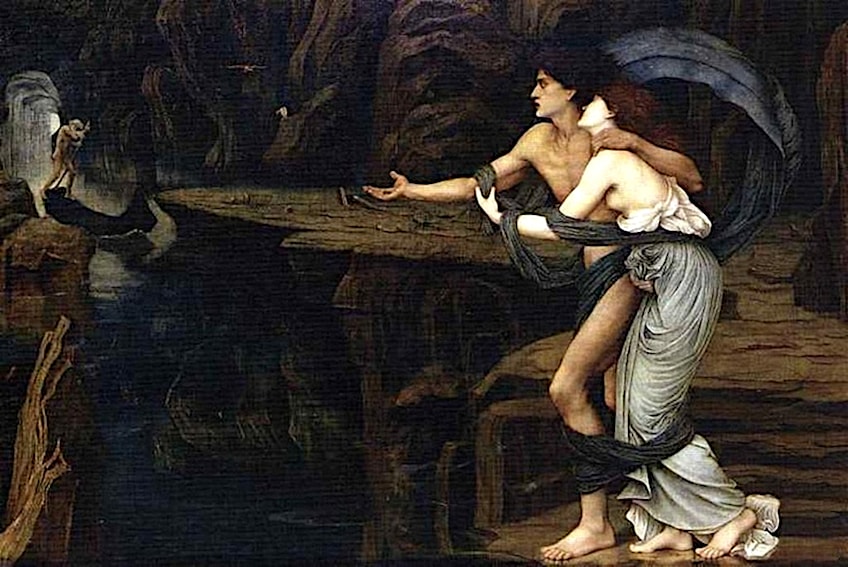 Orpheus and Eurydice on the Banks of the Styx by John Roddam Spencer Stanhope (1878); John Roddam Spencer Stanhope, Public domain, via Wikimedia Commons
Orpheus and Eurydice on the Banks of the Styx by John Roddam Spencer Stanhope (1878); John Roddam Spencer Stanhope, Public domain, via Wikimedia Commons
Followers of the mystery cults also believed that anyone seeking to learn more about the world could contact Nyx. Instead of depending on Apollo’s heavenly oracles, they thought that at the furthest ends of the world, Nyx inhabited a cave from which she issued more precise prophecies than any other deity was capable of. These mystery cults weren’t representative of the popular understanding of cosmology or the divine order of Greek mythology, but they did have an impact.
The concept of Nyx as a prophetic goddess was celebrated in Orphic cult poetry and hymns.
Role as a Mother
While the Orphic mysteries were unusual in that they held Nyx to be the genesis of all life, even conventional Greek religious thought regarded her to be an essential mother figure. As mentioned earlier, her most notable offspring, Hemera and Aether, were the result of her marriage to Erebus. In one of the first dualities of cosmological balance that would become crucial in Greek philosophy, Night and Darkness gave rise to their opposites, Day and Brightness.
It’s no wonder that most of her offspring, particularly those who were born without Erebus’ help, were identified with the darkness. Nyx, like other Greek gods, had offspring who mirrored more particular features of her own vast dominion.
Hypnos, the embodiment of sleep, was also among her offspring and came out every night as part of his mother’s entourage. The Oneiroi were the embodiments of dreams. They numbered in the 1000s and were often referred to as Hypnos’ children. Hypnos’ twin brother Thanatos was the embodiment of serene and painless death. Momos was also the embodiment of violent or unexpected death, usually accompanied by suffering and terror. Moros symbolized death and the powers that pushed humans to Momos and Thanatos.
 Sleep and Death, the Children of the Night by Evelyn de Morgan (1883); Evelyn De Morgan, Public domain, via Wikimedia Commons
Sleep and Death, the Children of the Night by Evelyn de Morgan (1883); Evelyn De Morgan, Public domain, via Wikimedia Commons
Momos was often linked to the Fates. There was no consensus about the Fates’ parentage, but Nyx was often regarded as their mother. The Keres were the embodiments of death’s necessity. They were depicted on battlefields as dreadful yet inevitable ghosts. Nemesis, the goddess of wrath, exacted vengeance on people who amassed unwarranted wealth, had an overabundance of good fortune, or committed crimes that went unpunished.
Philotes was the embodiment of love and camaraderie. Her name could also have been used to refer to sexual encounters that occurred while she was under her mother’s control.
Apate was the embodiment of duplicity and fraud, and she worked a lot at night. Homer described Eris, the goddess of conflict and discord, as a child of Zeus, although other accounts believed she was an offspring of Erebus and Nyx. Geras was an embodiment of old age, and he was typically portrayed as a feeble and withered man. Oizys was one of Nyx’s most evil children; she represented pain and anguish.
 Detail from the frescoes in the Palazzo Medici-Riccardi depicting the Barge of Charon with Nyx and Morpheus above by Luca Giordano (1684-1686); Luca Giordano, Public domain, via Wikimedia Commons
Detail from the frescoes in the Palazzo Medici-Riccardi depicting the Barge of Charon with Nyx and Morpheus above by Luca Giordano (1684-1686); Luca Giordano, Public domain, via Wikimedia Commons
The Personality and Attributes of Nyx
Nyx’s personality was typically connected with the enigmatic and primal qualities of darkness. While tales and portrayals of Nyx’s persona differ, she is typically portrayed as a powerful and enigmatic goddess. She was capable of affecting the mortal realm as well as the deities themselves, and thought to have power over the constellations and celestial bodies, and her presence was connected with the night sky’s vastness and endless depths.
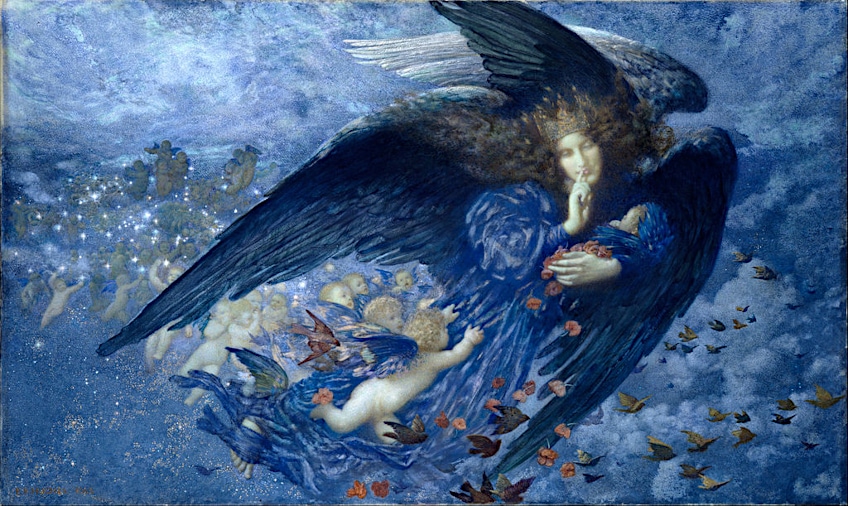 Night with her Train of Stars by Edward Robert Hughes (1912); Edward Robert Hughes, Public domain, via Wikimedia Commons
Night with her Train of Stars by Edward Robert Hughes (1912); Edward Robert Hughes, Public domain, via Wikimedia Commons
Nyx, being a goddess associated with mystery and darkness, often appeared as being distant and aloof. She was regarded as a divinity of enormous power, with an aura of mystery and a proclivity to conceal her intentions.
Nyx was known for her independence and seldom intervened directly in the lives of other deities or humans, rather lurking in the shadows, watching and exerting her influence silently.
Nyx’s Symbols
Nyx often appeared with stars in her hair or as a heavenly figure decorated with stars. Her relationship to the night sky and her status as a celestial deity was symbolized by the stars. While the moon was generally linked with the deity Selene, Nyx was also represented with lunar imagery on occasion, representing her nocturnal dominion and her connection to the night’s cycles. Nyx as the personification of the night was symbolized by the great expanse of the night sky, with its black beauty and glittering stars. It symbolized the enigmatic and limitless nature of her sphere of influence.
Because of their nocturnal nature, owls are often associated with Nyx. These birds were viewed as representations of intelligence, intuition, and the capacity to traverse the darkness, which corresponded to Nyx’s elusive and enigmatic personality.
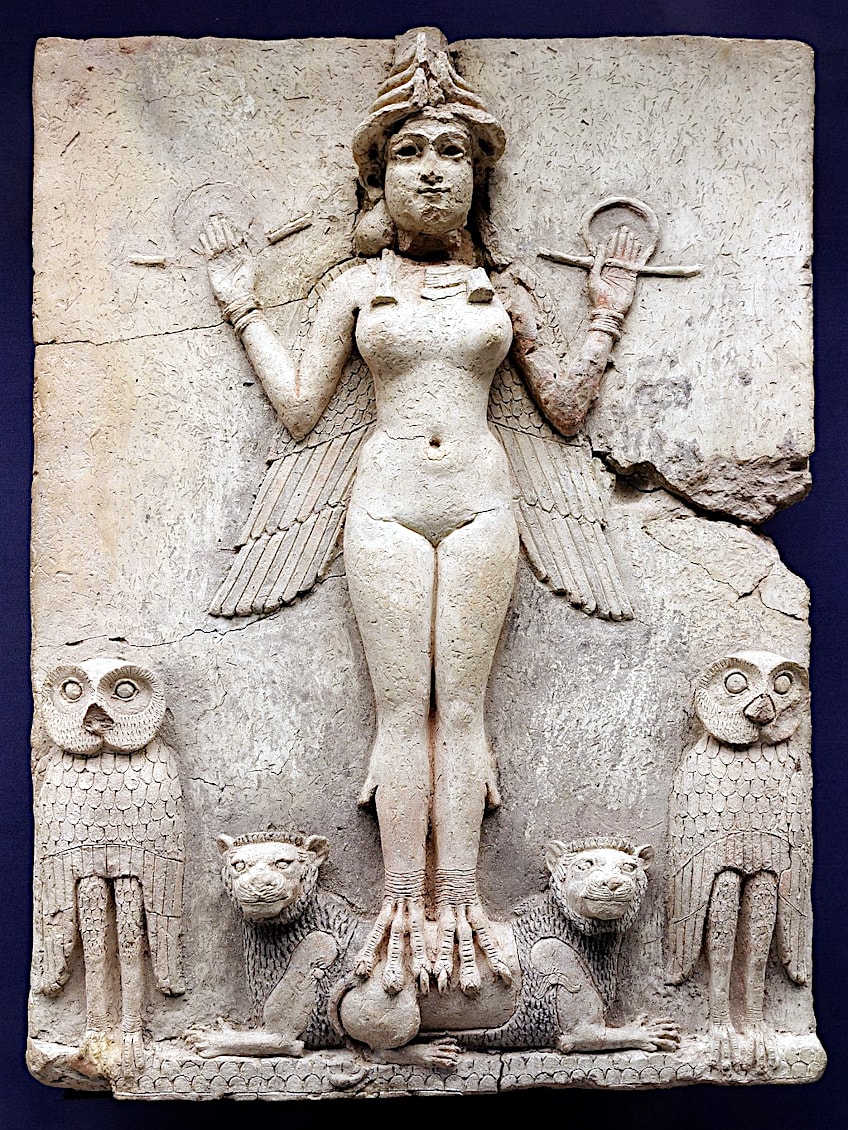 The Burney Relief showing the Mesopotamian Queen of the Night (19th-18th Century BCE); Gennadii Saus i Segura, CC BY-SA 4.0, via Wikimedia Commons
The Burney Relief showing the Mesopotamian Queen of the Night (19th-18th Century BCE); Gennadii Saus i Segura, CC BY-SA 4.0, via Wikimedia Commons
Nyx was occasionally seen clutching or accompanied by poppy flowers. The poppy represented dreaming and sleeping, which were influenced by Nyx, the goddess of night and sleep. Nyx was sometimes shown with a veil or a black cloak covering her body, highlighting her link with darkness, mystery, and secrecy. It symbolized her intriguing and secretive personality.
Nyx’s Myths
Many of the primordial gods sank into obscurity once their role in the creation of the cosmos was completed. Tartarus, for instance, remained a significant location but was rarely considered a physical character. A few, though, continued to appear in Olympian stories occasionally. While Gaia is the most well-known of them, Nyx also appeared in later mythology. When she did, she was portrayed as a deity to be feared and revered, even by the gods’ ruler himself.
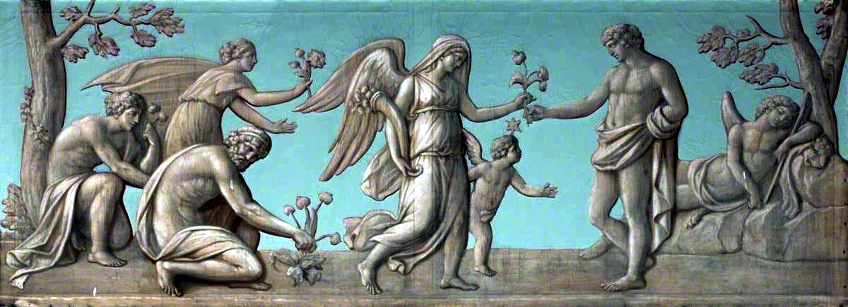 Night Distributing her Poppies with Morpheus Sleeping by an unknown artist (between 1759 and 1769); National Trust, Public domain, via Wikimedia Commons
Night Distributing her Poppies with Morpheus Sleeping by an unknown artist (between 1759 and 1769); National Trust, Public domain, via Wikimedia Commons
In an episode of the Iliad, Nyx preventing Zeus from receiving justice. Hera had previously asked Hypnos to make Zeus fall asleep so she could meddle with her loathed stepson, Heracles. When Zeus awakened and learned what had occurred, he became enraged and vowed to murder Hypnos. Zeus was furious, beating the rebellious gods and hunting for the god of sleep everywhere. Nyx, though, brought her child in to protect him.
Despite being the king of the gods and overwhelmed by rage, Zeus retreated. According to Homer, he was so fearful of enraging the goddess of the night that he did not dare to oppose her.
Deity of Both Danger and Calm
Despite being the mother of a number of evils and so terrifying that even Zeus was afraid of her, Nyx was also seen as a source of refuge. Nyx, like the night she symbolized, could be frightening but also serene and lovely. She may also be useful. Sailors, for instance, could see the stars they needed to navigate at night. In Agamemnon, the Greek forces praise Nyx for assisting them in winning the Trojan War. Under the cover of darkness, they were able to slip from the massive wooden horse that the unsuspecting Trojans had brought inside the walls and destroy the city, ending the ten-year siege.
 The Burning of Troy by Johann Georg Trautmann (18th Century); Johann Georg Trautmann, Public domain, via Wikimedia Commons
The Burning of Troy by Johann Georg Trautmann (18th Century); Johann Georg Trautmann, Public domain, via Wikimedia Commons
According to one Roman account, the common people embraced Nox, as she was known in Latin. The arrival of night signaled the conclusion of a long day of labor and a well-deserved rest at home.
Nyx was also occasionally useful to the gods. When Eos, the deity of the dawn, lost her mortal son in battle, Nyx descended abruptly over the earth to recover his body securely in the darkness. The Orphic hymns, which praised Nyx as the origin of all life, honored her for providing peace and repose to the world. While the night might be dreaded, it can also be welcomed because of its silence and the coming of prophetic and lovely dreams.
Nyx Through the Eras
While Nyx’s importance in Greek mythology faded throughout time, her core qualities and symbolic significance persisted in many forms. The Greek deities, including Nyx, were absorbed into the Roman pantheon following the Roman invasion of Greece. The Roman goddess Nox was identified with Nyx, and her qualities and associations were substantially retained. Ovid, the Roman poet, depicted Nyx as a strong and primordial character in his book Metamorphoses, emphasizing her relationship to night and darkness. Nyx appears in illustrated Christian manuscripts from the Byzantine and Medieval periods.
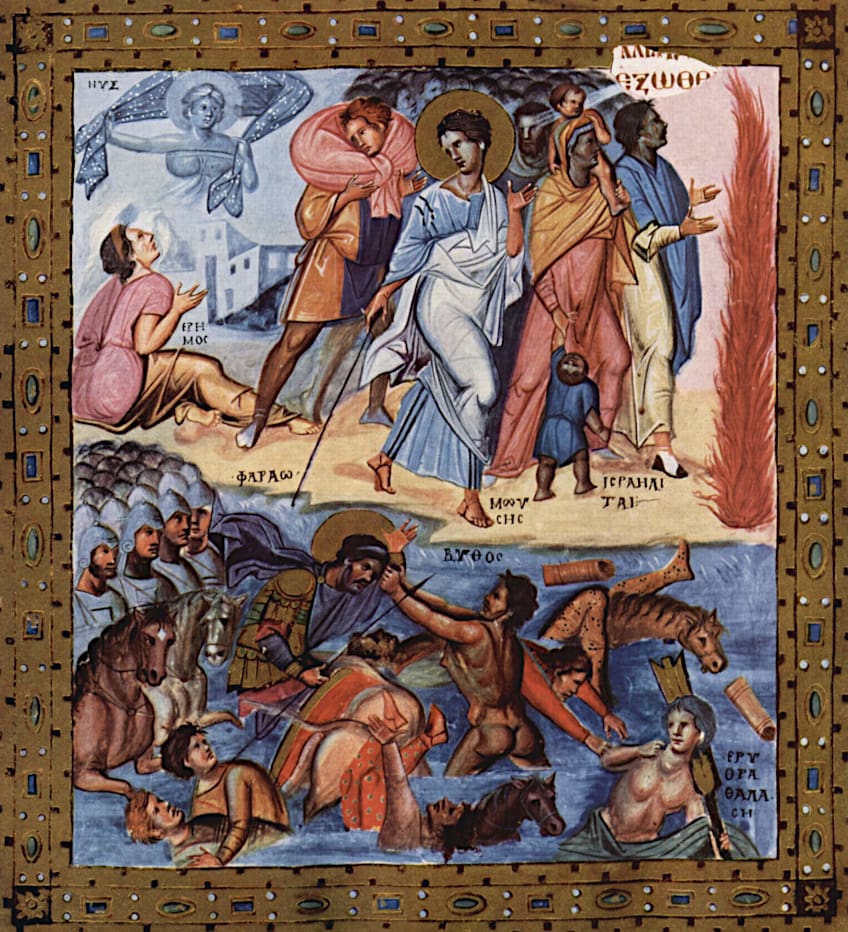 Illustration from a Byzantine Psalter showing Nyx in the upper left corner (beginning of the 10th Century); Byzantinischer Maler um 920, Public domain, via Wikimedia Commons
Illustration from a Byzantine Psalter showing Nyx in the upper left corner (beginning of the 10th Century); Byzantinischer Maler um 920, Public domain, via Wikimedia Commons
There was a revival of interest in ancient mythology and art during the Renaissance. Nyx was occasionally shown in artwork, especially in the form of a veiled or hooded figure that symbolized darkness and night. Her presence in this age, though, was not as prominent as that of other Greek mythological characters.
There was a revived interest in the mysterious, sublime, and emotional qualities of nature and the human experience throughout the Romantic era, which lasted from the late 18th to the mid-19th century. Romantic poets and authors were moved by Nyx’s link with mystery and the night. She was represented as a woman of awe-inspiring beauty and unfathomable power, producing a sense of the sublime. The Symbolist movement arose in the late 19th century as a reaction to the industrial age’s rationality and materialism. Symbolist painters and authors used symbolic images to communicate deeper, sometimes hidden meanings.
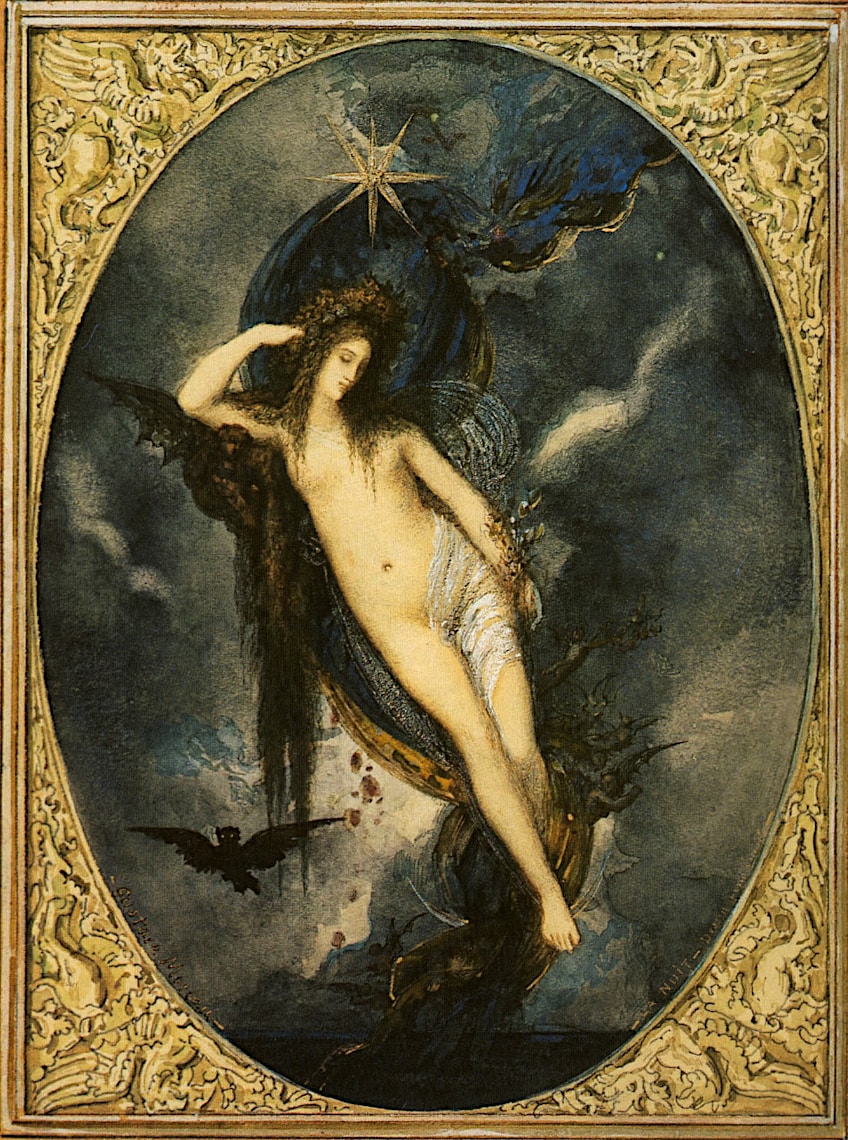 Nyx, Night Goddess by Gustave Moreau (1880); Gustave Moreau, Public domain, via Wikimedia Commons
Nyx, Night Goddess by Gustave Moreau (1880); Gustave Moreau, Public domain, via Wikimedia Commons
Nyx became a source of inspiration due to her link with dreams and the unconscious mind. She represented the psyche’s secret depths, the domain of dreams and creative thinking, and the enigmatic powers that lurk under the surface.
Nyx’s impact may be observed in numerous ways in current literature as well as popular culture. She can be found in fantasy fiction, notably in works influenced by or based on Greek mythology. In these interpretations, Nyx represents the force and appeal of the night, as well as concealed knowledge, transformational events, and cosmic secrets.
The Legacy of Nyx
Nyx is not as well-known as the 12 Olympian gods and goddesses. However, being the embodiment of the Night and one of the earliest Greek deities, she continues to play an important role in Greek mythology. She was beloved by the inhabitants of ancient Greece because she provided respite from the rigors of daily life. On the other side, she brought death and gloom, causing apprehension and terror.
The International Astronomical Union (IAU) named one of Pluto’s moons Nix after Nyx, continuing the custom of naming moons after mythical figures. Nyx is also the name of a well-known cosmetics brand, NYX Professional Makeup.
 Pluto’s moons in orbit; NASA Hubble, CC BY 2.0, via Wikimedia Commons
Pluto’s moons in orbit; NASA Hubble, CC BY 2.0, via Wikimedia Commons
Nyx in Western Psychology
Carl Jung’s idea of the “shadow” in analytical psychology bears some similarities to the domain of darkness and the unconscious connected with Nyx. The shadow reflects the psyche’s suppressed and concealed parts, particularly aspects of the self that are typically unconscious or judged undesirable. It is a characteristic of the individual’s personality that is frequently denied or projected onto others.
The concept of the shadow corresponds to Nyx’s link with mystery and the hidden parts of life.
The study of dreams and unconscious thought processes in psychoanalysis and deep psychology might be understood as being tangentially related to Nyx’s domain.
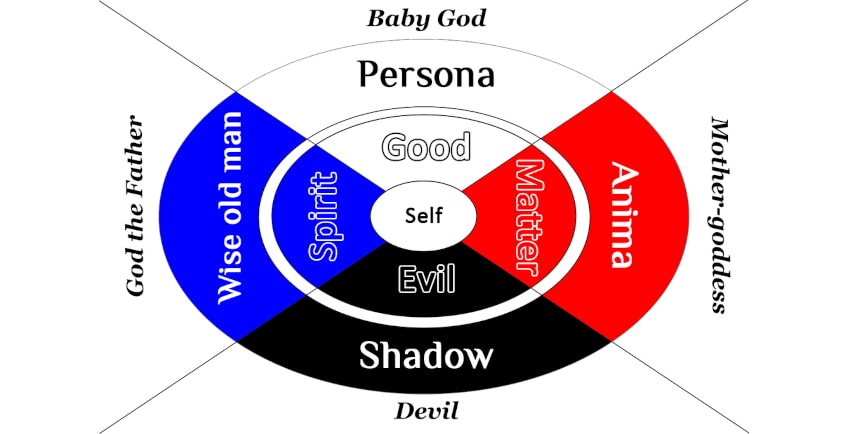 Depiction of the Jungian archetype Quaternity including the notion of the “Shadow”; Дмитрий Кошелев, CC BY-SA 4.0, via Wikimedia Commons
Depiction of the Jungian archetype Quaternity including the notion of the “Shadow”; Дмитрий Кошелев, CC BY-SA 4.0, via Wikimedia Commons
Nyx’s function as the goddess of the night and dreams is associated with the unconscious components of human experience, which are often accessed through dreams and serious contemplation. While Nyx is not expressly mentioned or quoted in the framework of Western psychology, her symbolic portrayal of darkness, the unconscious, and the secrets of the night can be interpreted as analogies to psychological notions and studies of the human mind.
The Roman Nyx: Nox
Nox was the embodiment of the night in Roman mythology. She personified the nocturnal hours’ tranquility and restfulness. She was also thought to be the mother of several deities, including Sleep (Somnus) and Death (Mors). Nox, like the Greek goddess Nyx, often appears as a shrouded or shadowy figure enveloped in darkness. She was linked with the heavenly bodies and stars that decorated the night sky. Nox’s domain represented the mysteries of the night as well as the transformational power of darkness.
 Roman statuette depicting Nox or possibly Selene (1st Century BCE); I, Sailko, CC BY-SA 3.0, via Wikimedia Commons
Roman statuette depicting Nox or possibly Selene (1st Century BCE); I, Sailko, CC BY-SA 3.0, via Wikimedia Commons
Nox was inextricably tied to the realms of sleeping and dreams. She was said to induce a peaceful condition of slumber and to control nightmares that happened during the night.
In Roman religion, Nox received little distinct worship. She was, nevertheless, regularly invoked alongside other deities or in religious ceremonies related to the night.
The Symbolic Lessons of Nyx, Goddess of Night
As a primeval goddess connected with the night and darkness, Nyx’s mythology contains symbolic and allegorical lessons. Nyx emphasizes the significance of accepting the darkness inside ourselves and the world around us. Recognizing and embracing the darker sides of our own psyche may lead to growth in ourselves and self-understanding, just as the night gives rest, contemplation, and regeneration. It tells us that there is a benefit in investigating the dark corners of our minds.
Nyx represents the hidden secrets and terrors that lie beneath the surface, but which explored, may lead to wisdom.
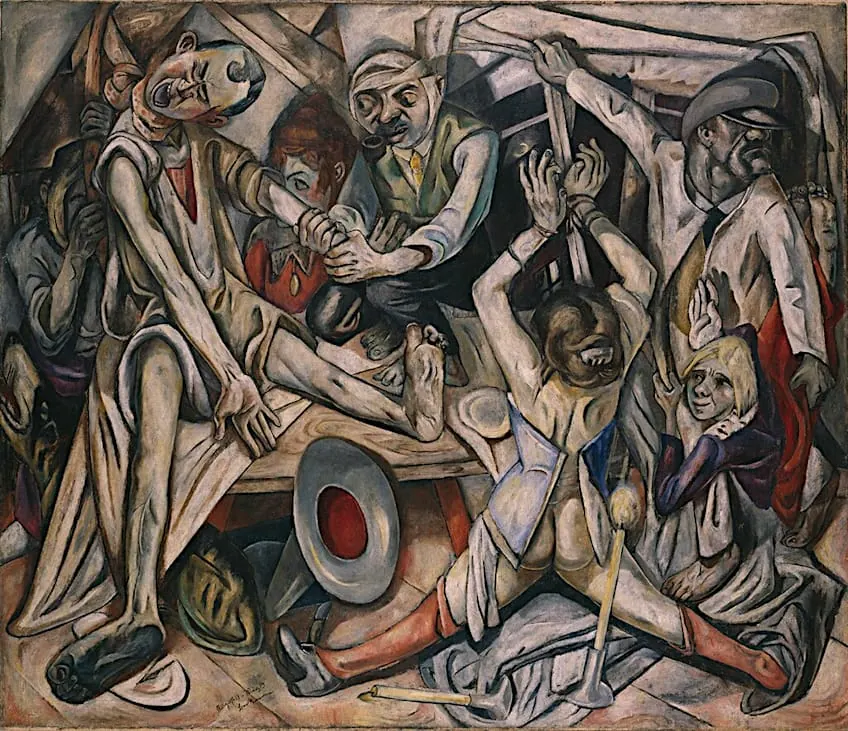 The Night by Max Beckmann (1918/19); Max Beckmann, Public domain, via Wikimedia Commons
The Night by Max Beckmann (1918/19); Max Beckmann, Public domain, via Wikimedia Commons
Nyx refers to the notion of cultivating a feeling of awe and inquisitiveness by acknowledging that not everything is capable of being easily comprehended or explained, leading to significant revelations and personal transformation. Nyx emphasizes the significance of rest and healing. In fast-paced and hectic lives, it is critical to appreciate the importance of balance and treasure moments of silence and tranquility. Nyx can symbolize the value of the restorative qualities of sleep, dreams, and calm contemplation. Nyx demands attention to dreams and the lessons they may contain, including deciphering the symbolic language dreams and distant memories.
When Edvard Much painted from memory the first girl he ever loved, he depicted her as she appeared one summer night.
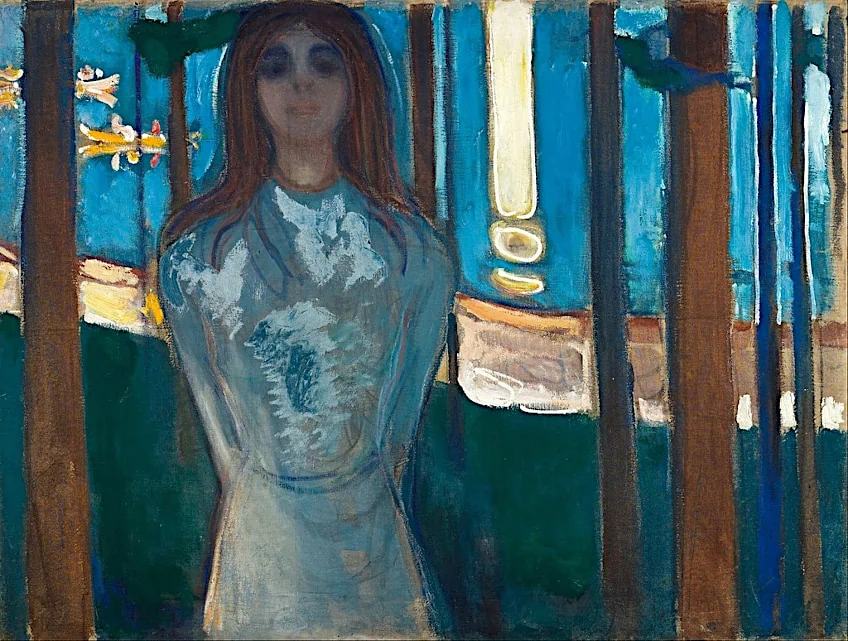 The Voice, Summer Night by Edvard Munch (1896); Edvard Munch, Public domain, via Wikimedia Commons
The Voice, Summer Night by Edvard Munch (1896); Edvard Munch, Public domain, via Wikimedia Commons
Nyx reflects life’s dualities and contrasts. She teaches that both light and darkness, night and day, are inextricably linked and required for balance. Humans may gain completeness and a better appreciation for the diversity of life by embracing the whole range of feelings and sensations represented by night.
That wraps up our Nyx facts article. Nyx was believed to have both a positive or negative influence, through her associations with sleep and death. This is not a goddess to be trifled with. Even Zeus did not dare challenge Nyx. In contemporary belief, the moonstone is used to commemorate her. It represents its owner’s personality and should be worn during the full moon. Even though Nyx had her home in the underworld, she is not an embodiment of evil in Greek mythology. However, due to her mysterious personality and association with fearful things, many people regard her as more of a villainous figure than she might actually be. As a primordial personification, Nyx was never the central figure of any cult but was revered as an associated deity in the cults of various gods and goddesses.
Frequently Asked Questions
What Is Nyx the Goddess Of?
Nyx is the Greek night goddess. The domain of Nyx includes the nocturnal hours, shadows, and hidden elements of reality. Nyx has a close connection with dreams and their symbolism as the deity of the night. In Greek mythology, Nyx is a member of the primordial generation of deities. She represents the very ancient and essential aspects of the universe that existed before the Olympian deities and the world as we know it.
Where Does Nyx Live?
According to most myths Nyx had her home in Hades. However, every night, she would leave her home to make her journey across the sky. The sky was seen as a massive dome that covered the surface of the earth. Every night, she would emerge and make her way across the evening sky, bringing a dark veil of mist as she journeyed. She would often be depicted traveling across the sky in a chariot. This role was seen as a very ancient one, and Nyx was thought to exist in this realm before even the earth had been formed yet.

I am deeply passionate about history and am constantly fascinated by the rich and complex stories of the past. As the editor-in-chief of learning-history.com, I have the opportunity to share this passion with a wide audience through the creation and distribution of engaging and informative content about historical events, persons, and cultures. Whether it’s through writing articles and blog posts or creating videos or podcasts, I strive to bring the past to life in a way that is both accurate and enjoyable. My expertise in history, combined with my strong writing and communication skills, allows me to effectively communicate complex historical concepts and make them accessible and interesting to a wide range of readers. I am truly grateful for the opportunity to share my love of history with others through my work on learning-history.com.


